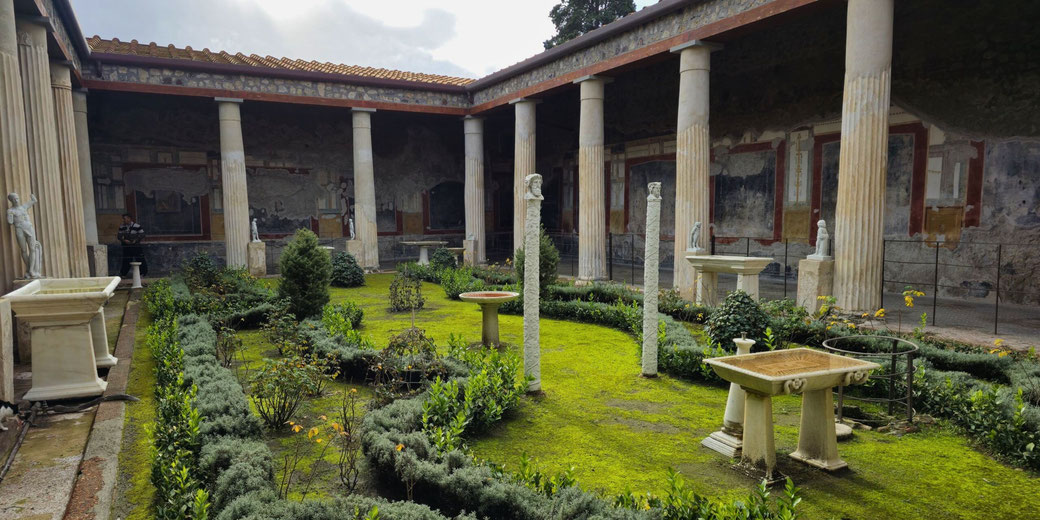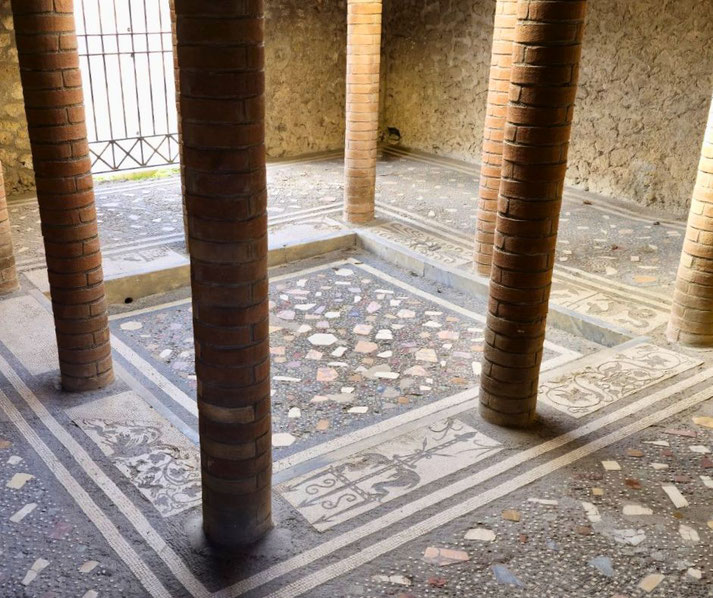What was it like to live in an ancient Roman villa?

A Roman villa was not just a simple home for regular people of the empire. It was actually an important statement of wealth and power.
These grand residences were impressive buildings of the ancient world that played a key role in defining the lifestyle of the wealthy Roman elite.
What is a Roman villa?
A Roman villa was a type of residence that emerged during the Roman Republic (509-27 BCE) and was originally an ancient Roman upper class country house.
The term villa can refer to different structures depending on location and period.
So, it could refer to a rural or suburban residence connected to relaxation, farming, or work.
Specifically, there were two main kinds of villas: the villa urbana, which was a country seat near the city, and the villa rustica, which was a farmhouse estate with a working area and a residential area.
Indeed, some villas were very luxurious and had features like mosaic floors, frescoes, gardens, baths, and fountains.
For instance, some famous examples of Roman villas are Hadrian's Villa at Tivoli, the Villa of the Papyri at Herculaneum, and the Fishbourne Roman Palace in Sussex.

The different buildings which made up a villa complex
Roman villas were known for their impressive architecture and elegant design.
The core of the villa consisted of numerous rooms arranged around a central courtyard or peristyle.
This open-air garden was a common feature in Roman domestic architecture and provided a serene retreat within the home.
It was typically adorned with decorative plants, fountains, and often, detailed statues.
You would find various rooms, including the atrium, the main formal reception room where the villa's owner, or 'dominus', would receive his guests.
Also, there was the 'cubicula' or bedrooms, and the 'triclinium', the formal dining room where sumptuous meals were served.
All of these were usually connect to the central peristyle so that they could be easy to access.

However, depending on their setting, the design and layout of the villas often differed based on their location and the period in which they were built.
For instance, villas in the Italian countryside were more likely to be focused on farming and would include extensive agricultural buildings, while those near the coast might have been built as luxurious retreats with an emphasis on relaxation and entertainment.
The estate villas could typically include various auxiliary buildings such as stables, barns, storage facilities, workshops, and sometimes even a private chapel or temple.
Who lived in a Roman villa?
A Roman villa was home to a diverse group of individuals, each with distinct roles and status within the household.
While the villa was a sign of wealth and prosperity, the life within its walls showed the clear-cut hierarchies and social distinctions of Roman society.
Chief among them was the 'dominus' or master, typically a wealthy Roman citizen who could be a member of the senatorial class, an equestrian, or a successful merchant, whose wealth enabled him to afford such a luxurious residence.
Often, he would use the villa as a country retreat away from his urban dwelling in Rome or other cities.
The family of the dominus, known as the 'domus', also resided in the villa. This included his spouse, children, and sometimes extended family members. Their rooms were usually private and well-furnished.
Meanwhile, the slaves performed a wide range of tasks, from domestic chores such as cooking, cleaning, and serving meals to managing the estate's agricultural work.
Slaves could also hold more specialized roles, such as tutors for the children, personal attendants, gardeners, or artisans.
However, their living quarters were distinctly separate, often smaller and more austere.
In addition, freedmen, or former slaves who had been granted their freedom, might also live on the estate.
They sometimes continued to work for their former masters, often in supervisory roles.
In some cases, they managed the estate in the absence of the dominus, maintaining the property and overseeing the work of the slaves.
Also, in larger villas, there may have been guest quarters for visiting friends, relatives, or dignitaries.
These guest quarters would typically have been comfortable and well-appointed, as hospitality was a significant aspect of Roman culture.
Lastly, the Roman villa was also home to a myriad of animals, including working animals like horses and oxen, pets such as dogs and birds, and game animals kept for hunting or entertainment.
What a typical day looked like
The daily life in a Roman villa was a combination of work, leisure, and social activities.
While the master and his family enjoyed a life of comfort and relaxation, the slaves worked tirelessly to ensure the smooth running of the household.
A typical day in the life of a Roman villa began at dawn. For the slaves, the day started early with chores such as cleaning the villa, preparing meals, tending to the gardens, or working on the agricultural lands.
Cooks would begin preparations for the day's meals. The villa's overseer, often a trusted slave or a freedman, would manage the day-to-day running of the estate, supervising the work of the slaves and ensuring that tasks were carried out efficiently.
For the dominus and his family, the day might begin with a light breakfast, often consisting of bread, cheese, and sometimes fruit.
After breakfast, the dominus might deal with the management of the estate, making decisions about planting and harvesting crops, selling produce, and any other financial matters.
He could also spend time receiving guests, discussing politics, or engaging in intellectual pursuits such as reading or writing.
Children in the villa would usually have a schedule full of education and recreation.
A private tutor might teach them reading, writing, mathematics, and principles of Roman law and morality.
Children might also learn about mythology and history through storytelling sessions.
Meals were an important part of the day in a Roman villa. The main meal, or cena, was a grand affair, often served in the late afternoon or early evening.
It was a social event, with family members, and sometimes invited guests, reclining on couches while slaves served a variety of dishes.
On hot days, the dominus and his family might spend time in the villa's garden, take a dip in the private bath, or indulge in a reading session in the villa's library.
Nighttime was typically for resting, though on special occasions, feasts or celebrations might extend into the night.
A villa was also a thriving business
Agriculture was the primary economic activity of most Roman villas. Some villas were self-sufficient estates that produced a variety of crops, fruits, and vegetables to feed their inhabitants and workers.
Depending on the region and the fertility of the land, common crops included grains, olives, grapes for wine, and vegetables.
Next, livestock farming was another important economic aspect. Animals such as sheep, cattle, pigs, and poultry were raised for their by-products rather than for food, such as wool, milk, and eggs.
To support these productions, many Roman villas were ideally placed near trade routes or bodies of water.
The extra produce from the villa, whether it was wine, olive oil, grain, or manufactured goods, was sold or traded in local markets or even exported further afield.
Meanwhile, the villa's inhabitants could purchase luxury goods not produced on the estate, such as spices, exotic foods or fine textiles.
To organise these tasks, a skilled steward or overseer, oversaw production, kept the accounts, managed the workforce, in order to ensure the villa's economic prosperity.
How to impress the neighbours
Owning a villa demonstrated the economic success and influence of the dominus.
Specifically, the advanced design, the rich decorations, the detailed mosaics and frescoes, the luxurious private baths and even the well-kept gardens all signaled wealth and taste, and they were intended to awe guests and elevate the owner's social standing.

In some cases, the location of a villa could also contribute to its status. Villas in certain desirable locations, such as the Bay of Naples, were particularly prized.
Similarly, the ability to entertain guests with lavish feasts, to maintain a large number of slaves and workers or to indulge in leisure activities like hunting, bathing or intellectual pursuits were all signs of wealth.
Many villa owners would even fund public works, sponsor festivals, or donate to religious institutions, often using the wealth generated from the villa's economic activities.
The religious items and practices within a villa
Every Roman villa typically housed a 'lararium', a sacred space dedicated to the household gods known as the 'Lares', who were believed to protect the home and its inhabitants.
There were daily rituals that were conducted in their honour. The dominus or another family member would usually lead these rituals, which involved prayers, offerings of food, and sometimes wine.
Inside, the lararium often featured small statues or images of the Lares and other important deities.
In addition, many Roman villas had private chapels or shrines dedicated to various Roman gods and goddesses. Larger villas might even have small temples within their grounds.
In addition, the spiritual life of a Roman villa often included veneration of the 'genius' of the dominus, the divine aspect of his personal spirit.
How the lavish Roman villas fell into ruins
The era of the Roman villa, like the empire itself, declined gradually rather than ending suddenly.
This gradual decline was connected to the broader social and economic changes of the transition from the late Roman to the early Medieval period.
In particular, one of the main factors in the decline of the Roman villa was the fall of the Western Roman Empire in the late 5th century AD.
The breakdown of central authority and the resulting unstable politics led to economic decline and disruption of trade networks, which in turn affected the financial health of the villas that depended heavily on farming and trade.
Other pressures included the invasions and migrations of different Germanic tribes into Roman territories.
The shift towards a more local, self-supporting economy, together with the decline of urban markets, reduced the need for large, productive villas and led to the emergence of smaller protected rural settlements, which gave rise to the manorial system of the Middle Ages.
At the same time, the decline in slavery, a key part of the villa system, meant fewer workers to maintain the large estates.
Meanwhile, the growing power of the Church influenced this process, with more villas given to the Church or converted into monastic communities.
It is important to note that the decline of the Roman villa was an uneven process that happened differently in various regions.
For instance, in some areas, such as parts of Britain, the villa system collapsed quite quickly after the end of Roman rule.
On the other hand, in regions of Italy, villas remained occupied and in use for several centuries.
By that point, the grand Roman villa, as a symbol of Roman elite culture and economic power, had largely disappeared.
What do you need help with?
Download ready-to-use digital learning resources
Copyright © History Skills 2014-2025.
Contact via email
With the exception of links to external sites, some historical sources and extracts from specific publications, all content on this website is copyrighted by History Skills. This content may not be copied, republished or redistributed without written permission from the website creator. Please use the Contact page to obtain relevant permission.





